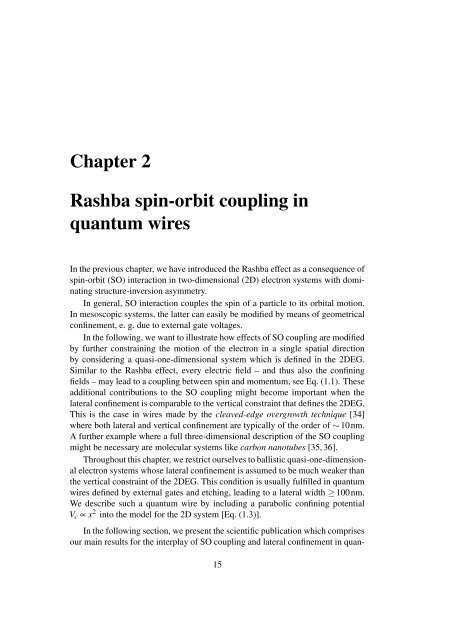Spin-orbit coupling and electron-phonon scattering - Fachbereich ...
Spin-orbit coupling and electron-phonon scattering - Fachbereich ...
Spin-orbit coupling and electron-phonon scattering - Fachbereich ...
You also want an ePaper? Increase the reach of your titles
YUMPU automatically turns print PDFs into web optimized ePapers that Google loves.
Chapter 2<br />
Rashba spin-<strong>orbit</strong> <strong>coupling</strong> in<br />
quantum wires<br />
In the previous chapter, we have introduced the Rashba effect as a consequence of<br />
spin-<strong>orbit</strong> (SO) interaction in two-dimensional (2D) <strong>electron</strong> systems with dominating<br />
structure-inversion asymmetry.<br />
In general, SO interaction couples the spin of a particle to its <strong>orbit</strong>al motion.<br />
In mesoscopic systems, the latter can easily be modified by means of geometrical<br />
confinement, e. g. due to external gate voltages.<br />
In the following, we want to illustrate how effects of SO <strong>coupling</strong> are modified<br />
by further constraining the motion of the <strong>electron</strong> in a single spatial direction<br />
by considering a quasi-one-dimensional system which is defined in the 2DEG.<br />
Similar to the Rashba effect, every electric field – <strong>and</strong> thus also the confining<br />
fields – may lead to a <strong>coupling</strong> between spin <strong>and</strong> momentum, see Eq. (1.1). These<br />
additional contributions to the SO <strong>coupling</strong> might become important when the<br />
lateral confinement is comparable to the vertical constraint that defines the 2DEG.<br />
This is the case in wires made by the cleaved-edge overgrowth technique [34]<br />
where both lateral <strong>and</strong> vertical confinement are typically of the order of ∼10nm.<br />
A further example where a full three-dimensional description of the SO <strong>coupling</strong><br />
might be necessary are molecular systems like carbon nanotubes [35, 36].<br />
Throughout this chapter, we restrict ourselves to ballistic quasi-one-dimensional<br />
<strong>electron</strong> systems whose lateral confinement is assumed to be much weaker than<br />
the vertical constraint of the 2DEG. This condition is usually fulfilled in quantum<br />
wires defined by external gates <strong>and</strong> etching, leading to a lateral width ≥ 100nm.<br />
We describe such a quantum wire by including a parabolic confining potential<br />
V c ∝ x 2 into the model for the 2D system [Eq. (1.3)].<br />
In the following section, we present the scientific publication which comprises<br />
our main results for the interplay of SO <strong>coupling</strong> <strong>and</strong> lateral confinement in quan-<br />
15
















